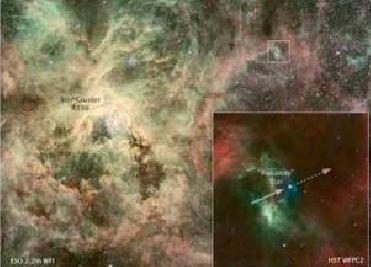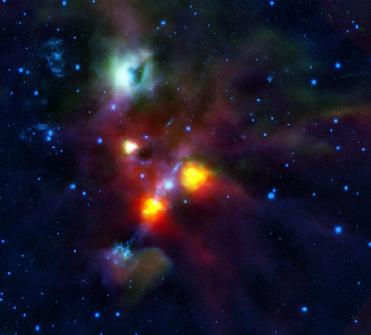
The runaway star (inset) which has fled from its home, the 30 Doradus nebula. A Hubble photo
WASHINGTON (BNS): A massive star running away at breakneck speed from its cradled home of a stellar nursery after being “kicked out” by its heftier siblings has caught the attention of astronomers.
The ‘homeless’ star, rushing away from a giant star cluster at more than 250,000 miles an hour, has been detected in the outskirts of the 30 Doradus nebula, also called the Tarantula nebula, 170,000 light-years away from Earth. The nebula is a huge star breeding ground lying in the nearby Large Magellanic Cloud.
NASA's Hubble Space Telescope has caught the blue-hot star which is 90 times more massive than our Sun. The star's home – the R136 giant star cluster – is nestled in the core of 30 Doradus nebula and contains many stars topping 100 solar masses each.
Astronomers believe that the star has been rendered homeless after an encounter with other heavier stars in its home cluster.
A runaway star can be born either after an encounter with one or two heavier siblings in a massive, dense cluster and get booted out through a stellar game of pinball. Or, the star may get a 'kick' from a supernova explosion in a binary system, with the more massive star exploding first.
In the case of the new-found star, its home – the R136 giant star cluster – “is sufficiently young, 1 million to 2 million years old, that the cluster's most massive stars have not yet exploded as supernovae,” according to Danny Lennon of the Space Telescope Science Institute.
“This implies that the star must have been ejected through dynamical interaction,” Lennon said.
The ‘wayward’ star will continue to streak across space and will eventually end its life in a titanic supernova explosion, likely leaving behind a remnant black hole, said team member Paul Crowther of the University of Sheffield in England.
The new findings, led by Chris Evans of the Royal Observatory Edinburgh, appear in the latest online edition of The Astrophysical Journal Letters.
 Previous Article
Previous Article Next Article
Next Article









The Indian Air Force, in its flight trials evaluation report submitted before the Defence Ministry l..
view articleAn insight into the Medium Multi-Role Combat Aircraft competition...
view articleSky enthusiasts can now spot the International Space Station (ISS) commanded by Indian-American astr..
view article